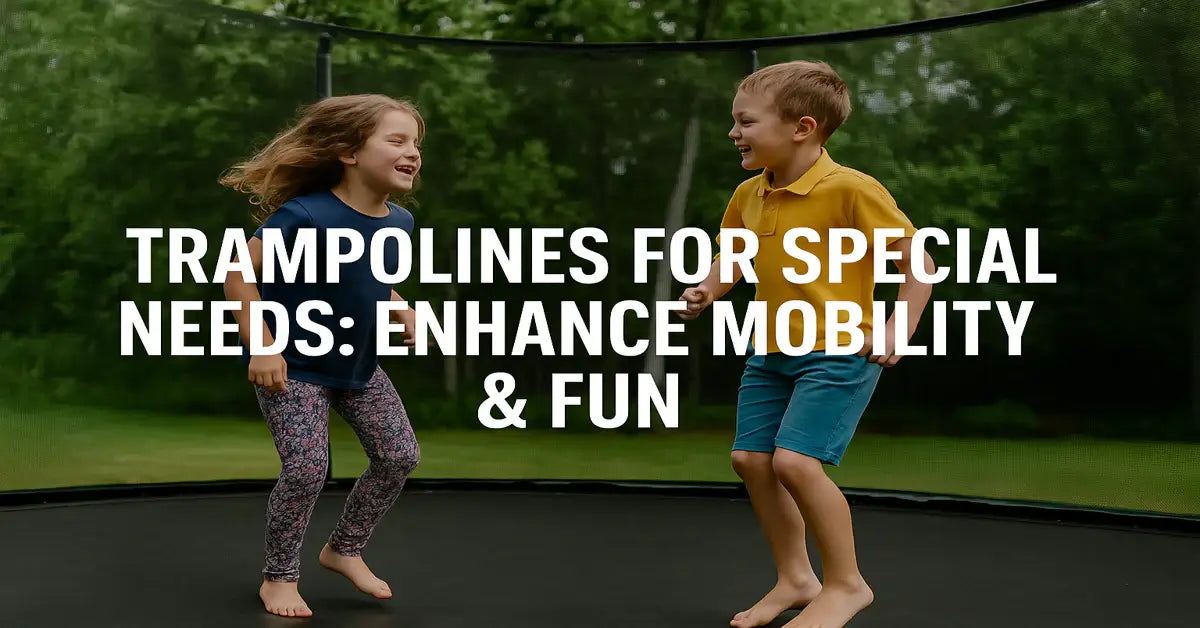
Trampolines For Special Needs
As parents, we’re always searching for ways to help our children thrive—and that includes finding activities that are both fun and supportive. For kids with specific needs, trampolines are more than just play equipment. They can be powerful tools that boost confidence, build strength, and create moments of pure joy.
Every child is different, and their playtime should reflect that. The right trampoline can do wonders for their physical, emotional, and sensory development.
Sensory Integration and Motor Skills
Improving Balance and Coordination
Bouncing isn’t just fun—it’s functional. With each jump, kids develop better balance, coordination, and muscle control. It’s a brilliant way for them to stay active while working on gross motor skills like jumping, turning, and holding posture. Think of it as physiotherapy in disguise—except it’s actually enjoyable.
Addressing Sensory Sensitivities
Many children with sensory processing challenges find trampolines incredibly soothing. The rhythmic motion can help regulate their senses and offer a sense of control. It’s like giving their nervous system a reset button. Over time, they become more comfortable with movement and better at handling sensory input in everyday life.
Enhancing Proprioception and Body Awareness
Jumping on a trampoline gives constant feedback about where the body is in space. This helps children become more aware of their movements and surroundings. It's especially helpful for those who struggle with body awareness or proprioception issues. Plus, it's a fantastic way to burn off energy and feel calm afterwards.

Social and Emotional Benefits
Encouraging Social Interaction and Play
Trampolines naturally bring people together. Whether it’s taking turns, bouncing side by side, or playing imaginative games, trampolines encourage social bonding. They offer a space where kids can interact without pressure—just shared laughter and movement.
Building Confidence and Self-Esteem
Each successful bounce, each small milestone, builds confidence. For children who often face challenges in traditional settings, trampolines provide a space where they can succeed on their terms. It’s empowering and joyful all at once.
Managing Anxiety and Stress
The up-and-down motion of bouncing can have a calming effect, almost like a moving meditation. Kids often feel more grounded and less anxious after a good trampoline session. It’s not just physical—it’s emotional release too.
Physical Health Benefits
Cardiovascular Health
Ten minutes of jumping can be as effective as a short jog. But for kids, it doesn’t feel like exercise—it feels like fun. This makes trampolines a sneaky but brilliant way to improve heart health without the complaints.
Strengthening Bones and Muscles
With every bounce, muscles engage and bones absorb gentle impact, helping build strength and density. It’s a low-impact way to support physical development—especially for children who may find other forms of exercise difficult or unappealing.
Choosing the Right Trampoline for Special Needs

Safety Features and Considerations
Enclosure Systems and Netting
Safety is key. Look for trampolines with full enclosures and sturdy netting that prevents falls and keeps children secure as they jump.
Padding and Soft Landing Mats
Soft, padded edges help protect against accidental bumps and falls. For children with sensory sensitivities, padding also adds a layer of comfort.
Frame and Matting Quality
A strong frame and durable mat ensure the trampoline stands up to daily use and play. Look for materials that are built to last and withstand different weather conditions.
Size and Accessibility
In-Ground Trampolines
These trampolines are flush with the ground, reducing the risk of falls and making access easier. They’re a great option for children with mobility challenges.
Wheelchair-Accessible Trampolines
Some trampolines are specially designed with ramps and spacious entry points, making it possible for children in wheelchairs to enjoy bouncing safely.
Budget and Value for Money
You don’t need the most expensive model to see the benefits. Choose a trampoline that suits your child’s needs and your budget. Many quality options are affordable and offer excellent value, especially when you consider the therapeutic benefits.

Trampolines for Special Needs in the UK
Finding Accessible Trampoline Facilities
Local Leisure Centres and Playgrounds
Across the UK, more leisure centres are offering inclusive play sessions. Some even host dedicated trampoline hours for children with additional needs—low lights, no loud music, and a slower pace.
Specialist Centres and Therapies
Some therapy centres include trampolines as part of their physical or sensory programs. These spaces are often supervised by trained staff who understand how to support children with a wide range of needs.
Working with Healthcare Professionals
Occupational Therapists and Physiotherapists
These experts often use trampolines during therapy sessions. They can also recommend the right type of trampoline for your child and show you how to use it for targeted support.
Special Needs Educators
Teachers and SENCOs may suggest trampoline play to help manage energy levels or aid focus. It’s worth asking if your child’s school or programme already incorporates trampoline use.
Safety and Practical Considerations
Supervision and Guidance
Adult Supervision and Support
Never leave children unsupervised on a trampoline. An adult’s presence helps ensure safety, reinforces rules, and offers support if needed.
Establishing Clear Rules and Boundaries
Setting simple, consistent rules—like one jumper at a time—can make trampoline time safe and stress-free. Visual reminders or picture cards can help children remember what’s expected.
Addressing Individual Needs
Sensory Accommodations and Modifications
Look for trampolines with features like quieter springs, enclosed designs, or soft textures. These small tweaks can make a big difference for kids with sensory sensitivities.
Personalised Exercise Plans
Work with a therapist to create a routine that suits your child. It might include warm-ups, set bounce patterns, or themed games—all designed to support specific developmental goals.



Leave a comment